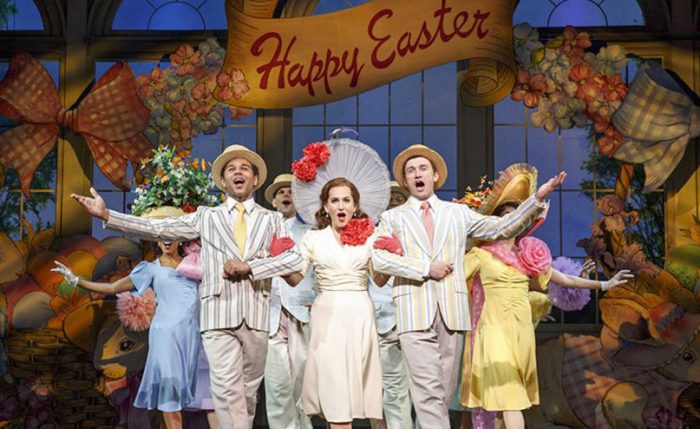
Irving Berlin conceived Holiday Inn as a live stage show, so the concept of adapting it as a musical for the stage seems natural.
In 1942 it premiered as a movie instead, and became one of the most-loved films of all time. In 2014 it finally came to a theater stage at Goodspeed in East Haddam, Connecticut, and in 2016 the Roundabout Theater brought it to Broadway,
On February 16, 1939, Berlin sent a letter to his lawyer: “Happy Holiday by Irving Berlin. This is a first rough draft for a revue. The important holidays in a year will be shown in rotation.” In April 1941, Berlin met film director Mark Sandrich: “I told him about my idea of a musical revue based on holidays and he thought it would make a perfect movie for Bing Crosby and Fred Astaire.” So the idea turned into a film, and a plot was constructed about a singer who retired and bought a farm in New England, and, finding it tough going, hit on the idea of turning the farm into an inn that would only be open on holidays.
This became one of the most popular movies of 1942 and two of the songs written for it — “Be Careful, It’s My Heart” (for Valentine’s Day) and “White Christmas”— were huge hits. A 1954 movie was centered on that song and borrowed a bit of its plot from Holiday Inn.
The Goodspeed Opera House, located in a small Connecticut town, is an appropriate locale, and the staff at Goodspeed is experienced with classic musicals. Gordon Greenberg and Chad Hodge beefed up the plot and wrote a new script, which Greenberg directed.
Tally Sessions and Noah Racey assumed the roles originally played by Crosby and Astaire. Sessions is amiable and likeable, while Racey is self-centered and brash. His character is the piece’s bad guy, but we can’t help being intrigued by him.
The new script makes the female roles stronger than in the movie. Patti Murin played the former owner of the Connecticut property, an independent woman who is courted by both of the leading men. Susan Mosher provided laughs as the inn’s wisecracking handywoman, Danny Rutigliano was a comically pugnacious agent, and Hayley Podschun was the ditzy former partner of the song-and-dance team.
When the show transferred to Broadway, bigger names were employed. Bryce Pinkham and Corbin Bleu assumed the roles originally played by Crosby and Astaire. Bleu’s personality and dancing stole the show. Pinkham was better in A Gentleman’s Guide to Love & Murder which showcased a kind of goofy charm; this role could use a stronger romantic baritone voice (like Crosby’s). Pinkham’s character needs to be the warm and lovable guy whom we root for. He seemed, instead, to be merely a pleasant nebbish.
Lora Lee Gayer played the former owner of the Connecticut property, an independent woman who is courted by both of the leading men. She is tempted by a career while her loved one wants to retire. Megan Lawrence was the handywoman, and Megan Sikora was the former partner.
Berlin had listed additional potential song titles for his original stage revue — including “I Pledge Allegiance to My Flag,””The Wedding of Capital and Labor,” “If Columbus Came Back Today,” and “We Fought the War to End All Wars” — but composed none of them. Berlin did include songs for Lincoln’s birthday and for Washington’s, and both of them have now been eliminated. So Greenberg and Hodge searched the Berlin trunk for additional compositions to fill out the evening.
“Let’s Take an Old-Fashioned Walk” from the 1949 Berlin show Miss Liberty provides a nice love duet. “Heat Wave” (introduced in his 1933 musical As Thousands Cheer) relates to the summertime, if not to a specific holiday. “Blue Skies” (written by Berlin in 1926) demonstrates the optimism of the innkeeper, while “What’ll I Do?” (written for Berlin’s 1923 Music Box Revue) is a poignant love song.
Murin also introduced a little-known Berlin creation, “Love Leads to Marriage / that leads to divorce / that leads to lawyers / Expensive, of course,” which was an uncharacteristic curiosity. Berlin wrote it in 1956 for a never-produced musical, The Legendary Mizners, a subject Stephen Sondheim addressed in his Wise Guys, renamed Bounce and finally Road Show between 1999 and 2008.
But the soul of Holiday Inn is the array of holiday-specific songs from the original movie. These include “White Christmas,””Easter Parade,” and “Song of Freedom” for Racey’s Fourth of July tap dance with firecrackers. “Let’s Start the New Year Right” sizzled with streamers and balloons. All of the scenes that commemorated holidays at the inn featured spectacular hoofing, choreographed by Denis Jones.
Greenberg’s direction made innovative use of Goodspeed’s tiny stage and cleverly reached out into the aisles to envelop the audience.
While I was happy to hear this wide array of Berlin songs, I was bothered by the truncation of many of them. Berlin knew that a song has better chance to become a hit when it’s reprised repeatedly in the show. In other words, better to trim the song list a bit and expand and repeat some of the songs. Would that there was time for more of that.
Below, a video highlight of the Goodspeed production: